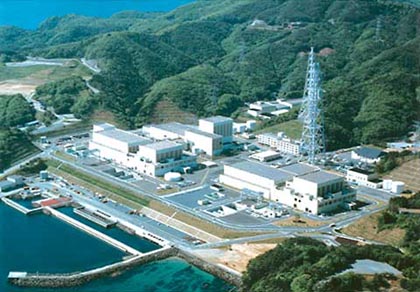Nuclear Power Development Toward CO2 Reductions
ON JANUARY 30, 2001, the No.3 boiling water reactor with an electrical
output of 825 MWe went into commercial operation at the Tohoku
Electric Power Company's Onagawa Nuclear Power Station in the
towns of Onagawa and Oshika, Oshika-gun, in Miyagi Prefecture.
The No.3 reactor is Japan's fifty-third commercial
nuclear reactor (the fifty-second reactor in operation). It is
the nation's twenty-ninth boiling water reactor, and the first
to start commercial operation in the new century. Experience with
older plants and the results of the light water reactor improvement
and standardization program were incorporated in the design of
this reactor. In addition, cutting-edge technologies and facilities
were adopted to enhance work efficiency in the reactor containment
vessel during periodical inspections and to reduce radioactive
waste.

Onagawa No.3 Reactor
The Tohoku Electric Power Company's Onagawa Nuclear Power Station.
The building on the right in the foreground houses the No.3 reactor.
In Japan, following on from the Onagawa Nuclear Power Station
No.3 reactor, three additional nuclear reactors are being constructed.
The Chubu Electric Power Company is constructing the Hamaoka Nuclear
Power Station No.5 reactor with an electrical output of 1,380
MWe for startup in January 2005. At the Tohoku Electric Power
Company's Higashidori Nuclear Power Station, the No.1 reactor
with an electrical output of 1,100 MWe is under construction,
scheduled for startup in July 2005. The No.2 reactor with an electrical
output of 1,358 MWe is under construction at the Hokuriku Electric
Power Company's Shika Nuclear Power Station, and is planned to
come on line in March 2006.
The Central Electric Power Council on March 28 announced a Summary
of the Electric Power Supply Program for Fiscal 2002, setting
forth capacity-expansion projects that Japanese electric power
companies will carry out in the next ten years. According to the
program, Japanese electric power companies are planning to construct
a total of thirteen nuclear reactors, including the three units
mentioned above, with a combined electrical output of 17,500 MWe
over the next decade. The total installed capacity will reach
63,240 MWe by the end of fiscal 2011. As a result, the share of
nuclear power plants in all power generating facilities will increase
from 20 percent (estimated) in fiscal 2001 to 23 percent in fiscal
2011. The percentage of nuclear power in the total power output
is also predicted to rise from an estimated 34 percent in fiscal
2001 to 41 percent in fiscal 2011.

During fiscal 2000, the electric power industry produced 311
million tons of carbon dioxide (t-CO2).
Under the Environmental Action Plan of the Electric Utility Industry,
the Federation of Electric Power Companies aims "to reduce CO2
emission intensity (CO2 emissions per unit
of end-use electricity) in fiscal 2010 by around 20 percent from
1990 levels." Based on the recently announced power supply program,
CO2 emissions throughout fiscal 2005 are
estimated to remain almost unchanged from fiscal 2000 levels.
If the power output in fiscal 2000 of nuclear power plants, which
do not produce CO2 in the power generation
process, were to be supplied by thermal power plants other than
LNG-fired plants, then CO2 emissions would
increase by 241 million tons. This is equivalent to around 20
percent of Japan's total CO2 emissions (1,225
million t-CO2), recorded in fiscal 1999.
Nuclear power plants, which do not produce CO2
in the power generation process and which discharge far fewer
life cycle assessment (LCA) CO2 emissions,
are the optimum source of power in the battle against global warming.

While placing the highest priority on nuclear safety, Japanese
electric power companies will continue their efforts to develop
nuclear power generation as a base power source that plays an
important role in Japan's electric power supply in order to secure
a steady supply of electricity and address global environmental
problems.
|